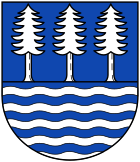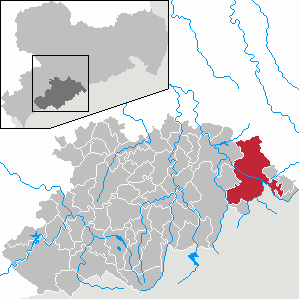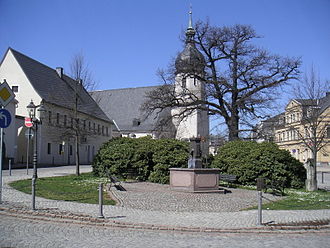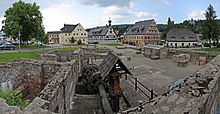Olbernhau
| coat of arms | Germany map | |
|---|---|---|

|
Coordinates: 50 ° 40 ′ N , 13 ° 20 ′ E |
|
| Basic data | ||
| State : | Saxony | |
| County : | Erzgebirgskreis | |
| Height : | 450 m above sea level NHN | |
| Area : | 125.36 km 2 | |
| Residents: | 10,840 (Dec. 31, 2019) | |
| Population density : | 86 inhabitants per km 2 | |
| Postal code : | 09526 | |
| Area code : | 037360 | |
| License plate : | ERZ, ANA, ASZ, AU, MAB, MEK, STL, SZB, ZP | |
| Community key : | 14 5 21 460 | |
| LOCODE : | DE OBU | |
City administration address : |
Grünthaler Str. 28 09526 Olbernhau |
|
| Website : | ||
| Mayor : | Heinz-Peter Haustein ( FDP ) | |
| Location of the city of Olbernhau in the Erzgebirge district | ||
Olbernhau is a small town in the Erzgebirge in Saxony . The "City of the Seven Valleys" was first mentioned in 1434.
geography
Geographical location
The city of Olbernhau is located in the Middle Ore Mountains on the border with the Czech Republic . It is also called "City of the Seven Valleys" because it lies in the valley of the Flöha and its side valleys, the streams of which flow into the Flöha. The seven valleys are Flöhatal, Schweinitztal , Natzschungtal , Bielatal , Rungstocktal , Bärenbachtal and Dörfelbachtal. Olbernhau is surrounded by mountains between 700 m and 921 m ( Lesenská pláň ( Hübladung ) on the Czech side - less than 5 km as the crow flies), which rise up to almost 500 m above the valley floor. The highest mountain on Olbernhauer Grund is the Steinhübel at 817 m above sea level .
City structure
- Parish parts:
- Leibnitzdörfel (Dörfel)
- Rungstock
- Farming village
- Districts:
- Grünthal (incorporated in 1937)
- Oberneuschönberg with the districts of Hirschberg and Niederlochmühle (incorporated in 1950)
- Niederneuschönberg (incorporated in 1950)
- Kleinneuschönberg with the Reukersdorf district (incorporated in 1950)
- Blumenau (incorporated in 1994)
- Rothenthal (incorporated in 1994)
- Pfaffroda (incorporated in 2017)
- Schönfeld (incorporated in 2017)
- Hallbach (incorporated in 2017)
- Hutha (incorporated in 2017)
- Dittmannsdorf (incorporated in 2017)
- Dörnthal (incorporated in 2017)
- Haselbach (incorporated in 2017)
history
First mention and origin of the name

The place name probably comes from the proper name Albert (Albernhaw, Alberthau, Albernhau, Albretshain) and represents the impact of the existing forest ( -hau ). Another theory of the origin of the name is that the first part of the name "Albern-" actually means as much as "silly" ( folly ) and the second part "au" is the shaped by alternating high and low water Niederung along a river. Since Olbernhau was probably a large lake after the last ice age about 11,000 years ago and the water has always changed and thus never stood still, even because of the many rivers, the water or the floodplain might have been a bit "silly". The beginnings of the village of Olbernhau are in the 12th and 13th centuries. The Bohemian nobleman Slavko von Hrabischitz founded the Cistercian monastery in Ossegg in 1196 , also to search for ores in the upper Flöhatal. The oldest documented mention dates from 1434 ( Albernaw ). This contract shows that Olbernhau was sold to the patrician Caspar von Berbisdorf.
The oldest evidence of mining activities comes from 1511. With the Reformation in 1539, Olbernhau became an independent parish . A school was first mentioned in 1556. The first stone church was consecrated on November 2, 1590.
Development of the place until 1945
Around 1684, the first people in Olbernhau began manufacturing rifles . In 1690 the first Olbernhau pipe smithy was built in the Rungstock Valley. In 1708 the rifle manufactory delivered 12,000 rifles to the Saxon army . A new school was built in 1748. The first practicing doctor can be proven in 1777. In 1815 a powder mill was built; in 1835, 1850 and 1865 there were explosions in the factory. In 1854 the last weapon was manufactured in Olbernhau. In 1868 a new school building was inaugurated and in 1869 the volunteer fire department was founded. With the opening of the Flöhatalbahn on May 24, 1875, Olbernhau was connected to the railway network. In 1878 a kindergarten was set up. During a violent thunderstorm on May 30, 1882, severe flooding occurred. The hospital was opened on January 1, 1885, a gas station was built in 1886 and gas lighting was introduced. In 1890, master brewer Clemens Ferdinand Köhler and his son Clemens Theodor Köhler opened the brewery "CF Köhler & Son" in house Am Markt 1. On July 5, 1892, Saxony's first power station was opened, and in 1895 the railway line to Neuhausen and a high-pressure water pipeline went into operation. On January 1, 1902, Olbernhau received city rights . On December 25, 1906, the Art Nouveau concert and ball house Tivoli was opened. The market bridge was widened in 1928 and the swimming pool opened in 1930. In 1936 the exhibition Grenzlandschaften , organized by the NSDAP , was presented there. In January 1932, a flood caused considerable damage. The grammar school was inaugurated as a high school in 1940. A dairy with a daily production capacity of 15,000 l was completed on Schäfereiberg in 1944.
1945 to the 21st century
After the end of the Second World War , some industrial companies settled in Olbernhau, including a sheet metal rolling mill (which had already existed before, but was extensively modernized and expanded), an art glass refinement (set up in 1946), many manufactories that produce wax flowers, wooden toys , furniture and Applied arts. The food and beverage industry as well as suppliers for vehicle construction also emerged. Administratively, Olbernhau was considered an industrial city in the Karl-Marx-Stadt district . In 1962, 14,200 inhabitants were counted. As a result of the political changes after 1990 and the reorganization of the Free State of Saxony, Olbernhau first belonged to the Marienberg district , and since 2008 to the Erzgebirge district .
From August 12th to 13th, 2002, the worst Flöha floods in history devastated the city center and all houses on both sides of the river. Thanks to donations from all over Germany, the damage, which amounted to several million euros, was largely repaired within a year. In the following years the banks of the upper Flöha were built with massive concrete surrounds; future floods should flow off in the deepened channel without damage. On January 1, 2017, Pfaffroda was incorporated into Olbernhau.
Population development
The following population figures refer to December 31 of the previous year with the territory January 2007:
| 1982-1988 | 1989-1995 | 1996-2002 | 2003-2009 | 2010-2013 |
|---|---|---|---|---|
| 1982: 13.903 | 1989: 13,260 | 1996: 12,255 | 2003: 11.284 | 2010: 9,936 |
| 1983: 13.813 | 1990: 12.997 | 1997: 12.190 | 2004: 11.096 | 2011: 9,780 |
| 1984: 13.734 | 1991: 12,650 | 1998: 12,079 | 2005: 10,882 | 2012: 9,439 |
| 1985: 13,643 | 1992: 12,669 | 1999: 11,959 | 2006: 10,716 | 2013: 9,276 |
| 1986: 13,517 | 1993: 12.608 | 2000: 11,810 | 2007: 10,535 | 2014: 9,181 |
| 1987: 13,492 | 1994: 12,523 | 2001: 11,591 | 2008: 10,362 | 2015: 9.233 |
| 1988: 13,434 | 1995: 12,412 | 2002: 11.405 | 2009: 10.100 |
The table shows on the one hand that the number of inhabitants in the GDR remained relatively constant, on the other hand it can be seen that more and more people are leaving Olbernhau, which is probably due to the lack of jobs.
Incorporations
With the incorporation of Pfaffroda in 2017, currently the last incorporation into the city of Olbernhau, the city is one of the largest cities in Saxony. In the Erzgebirge, the city of Olbernhau is the second largest city in terms of area after the city of Marienberg.
The city is planning a merger with Heidersdorf , Seiffen and Deutschneudorf, if necessary . Seiffen is aiming for a merger with Heidersdorf and Deutschneudorf.
politics
City council
Since the municipal council election on May 26, 2019 , the 22 seats of the city council have been distributed among the individual groups as follows:
| Party / list | Seats | + / - | |
| CDU | 8th | - 3 | |
| SPD | 4th | - 1 | |
| FDP | 3 | ± 0 | |
| LEFT | 1 | - 2nd | |
| AfD * | 1 | + 1 | |
| BI FBO | 3 | + 3 |
* Mathematically, the AfD is actually entitled to three seats, but it only occupies one.
mayor
- 1990–2015: Steffen Laub (CDU)
- since 2015: Heinz-Peter Haustein (FDP)
coat of arms
Regarding the city coat of arms, it is stated that the town, which was elevated to the status of a city with a revised city order in 1902, no longer bears the frog in its coat of arms, “but rather three spruce trees stretch their crowns into the air above blue and white water waves, a symbol of how strong roots are in water and wood rest its strength and prosperity ”.
Town twinning
There has been a partnership with Stadtbergen in the Bavarian administrative district of Swabia near Augsburg since 1989 and with Litvínov in the Czech Republic and Brie-Comte-Robert in France since 1992 . A partnership has also been established with Pratovecchio Stia in Tuscany , Italy .
Since November 1, 2004, the city has been a member of the Erzgebirge Regional Management, a regional initiative of the Erzgebirgskreis and ten other municipalities in the Erzgebirge .
Culture and sights
- see also: List of cultural monuments in Olbernhau
Buildings and places
The city through which the Silver Road runs is primarily developing tourism . Olbernhau is rich in natural beauties, as a starting point for hikes on foot or by bike, for trips into the surrounding area with its scenic and cultural-historical features, the city has a convenient location.
In Olbernhau there are two church buildings , the Evangelical Lutheran Church (address Blumenauer Straße 2) with a rectory, a new community center (under construction) and an adjoining cemetery, and the Roman Catholic Church (address Auf der Bleiche 28).
Museums
- Saigerhütte Olbernhau-Grünthal
The Saigerhütte Grünthal is a largely preserved ironworks , about 2.5 kilometers southeast of the city center. Due to its closed collection of individual monuments, it is considered a worldwide unique monument to smelting in the Saiger process . It includes, among other things, existing only in remnants smelter, the mansion, the still functioning Althammer with its tail wasserradgetriebenen hammers and homes of the workers.
To complete the monument complex there are a variety of leisure activities: small shops, the Hotel Saigerhütte with the restaurant Hüttenschänke (in the historic buildings Hüttenschänke and Haus des Aufrichters ), a bowling alley and the Stockhausen play and adventure world .
- Museum Olbernhau
The museum located on the market in a building of the former manor houses permanent exhibitions on the city and economic history as well as the development of folk art. The exhibits include a farmer's parlor from around 1800 and a Christmas pyramid over three meters high .
Memorials
- Memorial in the Volkspark for the victims of fascism , the back of which commemorates the communist Hugo Franz , who was murdered in Neuengamme concentration camp
- Memorial stone on Zöblitzer Strasse , also in memory of Hugo Franz
- Grave site and memorial stone in the local cemetery for an unknown concentration camp inmate
- See also the list of stumbling blocks in Olbernhau
European forge town
Olbernhau is a member of the Ring of European Blacksmith Cities , which has set itself the goal of promoting the regional diversity of the blacksmithing trade and metal design in the global unity of Europe at all levels.
theatre
- Theater in the museum: The area of the Saigerhütte Grünthal serves as a performance location for one-person plays that show, among other things, the life of Barbara Uthmann .
- The Variabel Theater is located in the former manor house .
Sports
Olbernhau has the following sports facilities
- Outdoor pool with beach volleyball court, table tennis tables, open-air bowling alley, open-air chess
- Educational swimming pool with sauna
- Bowling and skittle alleys
- Mini golf course
- Frankwarte ski lift
- Tennis court
- Multi-purpose hall Grünthal
- Sports complex, consisting of a modern sports hall and a sports field equipped with floodlights
- Sports and soccer fields
- Stadium on Blumenauer Strasse (capacity: around 4,000 seats)
Sports clubs based in Olbernhau are
- SV Olbernhau (soccer), formerly Stahl Olbernhau: The traditional soccer club currently plays in the state class West, but enjoys an unusually high audience in this league. Up to 1,000 spectators watch the home games in the stadium on Blumenauer Straße.
- TSV Olbernhau
- ST Ore Mountains
- Olbernhauer Tennis Club eV
Regular events
- Every year in August, the Olbernhauer bike tour takes place with a choice of routes of up to 140 km and over 2,000 participants from Germany and abroad.
- In December, the Christmas carol singing, supported by the MDR , takes place in the Rittergutshof.
Economy and Infrastructure
The manufacture of weapons of Olbernhau was from the 16th century to 1828, an economic factor "Olbernhauer gun industry" in the town. The origins of the Saigerhütte can be found in 1527 when Hans Lienhart was founded. Later it was owned by the Uthmann family and was acquired by Elector August in 1567 . With the protection of the elector, the production of weapons in Olbernhau was expanded.
Primarily founded by the Saigerhütte and continued by the Saxon copper and brass works FA Lange and the VEB Blechwalzwerk Olbernhau , Olbernhau has developed into the economic heart of the area over the centuries.
An important employer in the city is Wätas Wärmetauscher Sachsen GmbH , a company that produces heat exchangers for the recovery of energy. This company is the current main sponsor of the second division soccer club FC Erzgebirge Aue .
traffic
The Silberstrasse and the Deutsche Alleenstrasse run through Olbernhau .
Rail transport
The Olbernhau train station has an eventful transport history:
-
Flöhatalbahn
Chemnitz - Flöha - Pockau-Lengefeld - Olbernhau - Olbernhau-Grünthal - Oberneuschönberg - Neuhausen -
Schweinitztalbahn
Olbernhau-Grünthal - Niederlochmühle - Oberlochmühle - Deutschkatharinenberg - Deutschneudorf
On the Flöhatalbahn , the RB 81 Chemnitz – Olbernhau-Grünthal line of the Erzgebirgsbahn runs every hour Monday to Friday and every two hours on weekends.
Bus transport
The Olbernhauer bus station is served by the Erzgebirge regional traffic.
Medical supplies
As a standard care hospital, the Mittleres Erzgebirge hospital has a branch in Olbernhau in addition to its main location in Zschopau . The house in Olbernhau has 100 beds.
education
- Mining educational trail : The market in Olbernhau is the starting point of a German-Czech mining educational trail, which leads over 14 stations to Deutschkatharinenberg .
- City library: The city library located in the former manor has a collection of around 13,000 items (as of 2014).
- Adult Education Center: founded in 1919 - today located in the Grünthal district, the largest adult education center in the Ore Mountains region.
Personalities
literature
- The parish of Olbernhau. In: New Saxon Church Gallery, Ephorie Marienberg. Strauch Verlag, Leipzig, Sp. 539-624
- Olbernhau . In: August Schumann : Complete State, Post and Newspaper Lexicon of Saxony. 11th volume. Schumann, Zwickau 1824, pp. 792-806. ( Digitized version )
- Olbernhau. In: Max Grohmann : Das Obererzgebirge and his cities , pp. 1-40 of the 11th chapter, Graser Annaberg 1903
- About Olbernhau and Seiffen (= values of our homeland . Volume 43). 1st edition. Akademie Verlag, Berlin 1985.
- District Office Middle Erzgebirgskreis (Hrsg.): On the history of the cities and communities in the Middle Erzgebirgskreis . A timetable (parts 1–3).
- Rolf Morgenstern: Chronicle of Olbernhau for the 750th anniversary. Olbernhau, 2010. ( PDF - 8 MB )
- Paul Ottokar Pinder: History of the Olbernhau church trip . Fiedler, Olbernhau 1889 ( digitized version )
- Richard Steche : Olbernhau. In: Descriptive representation of the older architectural and art monuments of the Kingdom of Saxony. 5th issue: Amtshauptmannschaft Marienberg . CC Meinhold, Dresden 1885, p. 24.
Web links
- Website of Olbernhau
- Olbernhau in the Digital Historical Directory of Saxony
Individual evidence
- ↑ Population of the Free State of Saxony by municipalities on December 31, 2019 ( help on this ).
- ^ Rolf Morgenstern: Olbernhauer Chronicle for the 750th anniversary. Accessed January 21, 2020 .
- ^ Meyers New Lexicon in eight volumes. VEB Bibliographisches Institut Leipzig, 1964/65, Volume 6, Olbernhau; P. 257.
- ↑ Source: State Statistical Office of the Free State of Saxony
- ↑ Statistics Saxony - Results of the 2019 municipal council elections in Olbernhau
- ^ Homepage of the regional management of the Erzgebirge , accessed on March 16, 2015
- ↑ Homepage parish Olbernhaus ( Memento from February 16, 2015 in the Internet Archive )
- ↑ Brief information on the cath. Olbernhau Church
- ^ Alfons Diener-Schoenberg: History of the Olbernhauer Gun Industry , 1914 ( online at archive.org ).

















